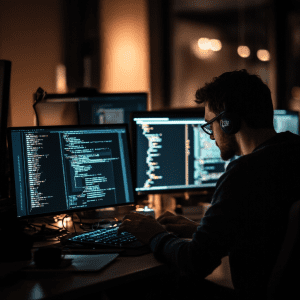Navigating the Future of Secure Software Engineering
 In an age where data breaches and cyber-attacks have become daily headlines, the realm of software development stands at the crossroads. The strategies and methodologies employed not only determine the functionality and user experience of applications but also their resistance to potential threats. This article delves into the foundational principles, advanced methodologies, testing paradigms, and futuristic visions of secure software engineering.
In an age where data breaches and cyber-attacks have become daily headlines, the realm of software development stands at the crossroads. The strategies and methodologies employed not only determine the functionality and user experience of applications but also their resistance to potential threats. This article delves into the foundational principles, advanced methodologies, testing paradigms, and futuristic visions of secure software engineering.
Laying the Foundations: Principles of Secure Software Engineering
Software, at its core, serves as an instrument to solve problems and enhance efficiencies. Yet, it becomes a double-edged sword when security isn’t integral. Understanding the foundational principles of secure software engineering is crucial in today’s digital environment. It distinguishes between mere functionality and genuine resilience.
(Visit Jason's Amazon Authors Page)
While every developer strives to write bug-free code, secure software engineering emphasizes the importance of anticipating threats. It isn’t just about catching errors but predicting and mitigating potential vulnerabilities from the get-go. This proactive approach ensures that security considerations are embedded, not just added as an afterthought.
In a world dominated by interconnected systems, the principles of secure software engineering also encompass a broader ecosystem. From cloud platforms to IoT devices, these principles advocate for a holistic view, ensuring every touchpoint is safeguarded against potential risks.
Recommendation: Cybersecurity professionals must prioritize continuous learning, understanding, and implementing the foundational principles of secure software engineering. It’s essential to embrace a proactive approach, emphasizing anticipation over mere reaction.
Building on Solid Ground: Secure Coding Practices & Software Security Testing
Software vulnerabilities are the gateways for cyberattacks. Recognizing and addressing them forms the crux of secure software development. Secure coding practices, therefore, become the building blocks. These practices are not static but evolve with the threat landscape. From injection attacks to cross-site scripting, understanding these vulnerabilities and their mitigation strategies is paramount.
Yet, recognizing vulnerabilities in code isn’t enough. Software security testing serves as the validation phase, ensuring that codes written are not just efficient but also secure. Through methodologies ranging from static analysis to dynamic testing, developers can unearth potential weak points, ensuring a fortified defense against threats.
It’s worth noting that the effectiveness of software security testing isn’t determined merely by the number of vulnerabilities detected. Instead, it’s about understanding the root cause, ensuring that similar vulnerabilities don’t reappear in future iterations or other parts of the application.
Recommendation: Invest in cutting-edge tools and training sessions focused on secure coding practices. Regularly review and update these practices, and ensure rigorous software security testing is an integral part of the development cycle.
Adapting to Modern Development Methodologies: Security in Agile & DevSecOps
Agile and DevOps have revolutionized the way software is developed, tested, and deployed. Yet, in the race to achieve operational efficiency, security can’t be left behind. This realization has given birth to practices that integrate security into these methodologies, ensuring that it isn’t just an add-on but an integral part of the process.
In Agile, the iterative development process provides ample opportunities for continuous security integration. By embedding security checks at each stage, developers can ensure that every release, every iteration is fortified against potential threats. It’s not just about building fast but building securely.
The DevSecOps approach, on the other hand, brings security considerations right from the design phase. With real-time vulnerability assessments, automated security tests, and security-focused code reviews, DevSecOps ensures a comprehensive, end-to-end security approach in the software development lifecycle.
Recommendation: Embrace Agile and DevSecOps but with a security-first mindset. Ensure that every stage, every process, every tool employed is evaluated from a security perspective, bridging the gap between speed and safety.
Gazing into the Future: Predictions and Preparations for Upcoming Challenges
As we look to the horizon, the future of secure software engineering promises exciting innovations. The integration of artificial intelligence and machine learning into security paradigms can revolutionize vulnerability detection, shifting from reactive strategies to predictive ones. Imagine a software ecosystem that doesn’t just respond to threats but anticipates them!
Furthermore, as quantum computing becomes a reality, it will redefine encryption standards. While it promises unprecedented computational capabilities, it also presents a new set of challenges to current security protocols. Secure software engineering must evolve in response, ensuring that it remains a step ahead of potential adversaries.
Blockchain’s promise of decentralized and tamper-proof systems can also shape the way software integrity is maintained. With smart contracts and transparent processes, the future might witness more automated and secure software life cycles.
Recommendation: Stay updated with the latest technological advancements. Invest in research and development, focusing on how emerging technologies can impact and enhance secure software engineering practices.
Conclusion
The journey of secure software engineering is ongoing, with new challenges and innovations on the horizon. By understanding and implementing foundational principles, adapting to modern methodologies, and preparing for future challenges, the world of software development can ensure a secure, resilient digital future. The onus is on us, the cybersecurity professionals, developers, and stakeholders, to navigate this journey with diligence and foresight.
